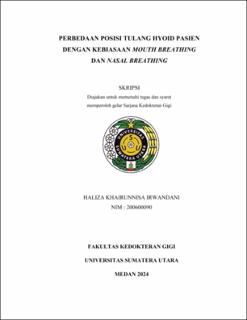| dc.description.abstract | The hyoid bone's mobility and adaptability contribute to its variable position, which is
diagnostically significant in identifying mouth breathing. Changes in the position of
the hyoid bone can serve as an important diagnostic guide in identifying mouth
breathing. This study aimed to assess differences in hyoid bone position between mouth
and nasal breathers aged 9-13 using lateral cephalograms. A descriptive analytical
approach was employed, examining 60 patient samples from the Orthodontic Clinic at
RSGM USU. Hyoid bone position was determined via the Bibby & Preston hyoid
triangle method, with statistical analysis conducted using the independent samples ttest.
Results indicated mouth breathers had larger mean values for C3-RGn (62.88 ±
9.23) and C3-H (37.45 ± 4.50), suggesting a more posterior and inferior hyoid bone
position. Similarly, mouth breathers showed higher mean values for H-RGn (37.53 ±
6.11) and H-H' (11.18 ± 3.49), indicating significant anteroposterior and vertical
differences compared to nasal breathers. Notably, while significant differences were
observed in C3-H and H-RGn, C3-RGn values didn't differ significantly between the
two groups. However, significant disparities were found in H-H' values, emphasizing
the vertical distinction between mouth and nasal breathers. In conclusion, mouth
breathers exhibit a more posterior and inferior hyoid bone position compared to nasal
breathers, underscoring the impact of breathing habits on hyoid bone orientation. | en_US |


